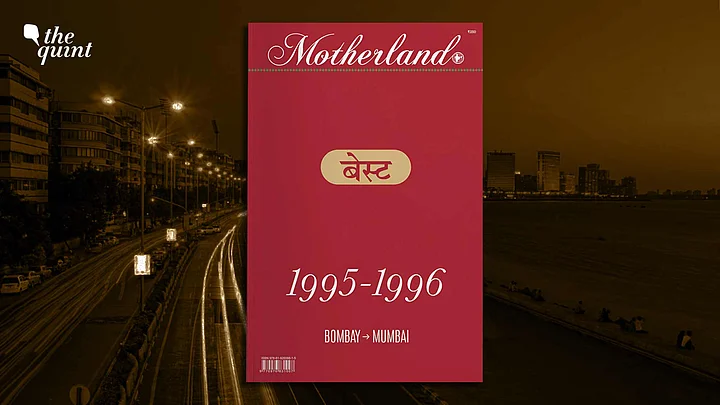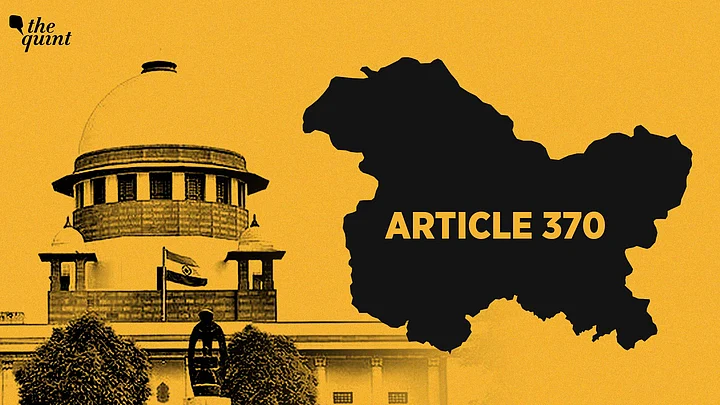Motherland is a journal of experience, with each issue revolving around a different theme. Its latest issue Bombay (1995) - Mumbai (1996) pieces together sharp, poignant pieces that transport you to another, crucial time. The articles are short, and each page is focused on design— dictated by the subject. Flipping through the journal gives you the uncanny feeling of looking at 1995 and 1996 through the window of a time machine that is in motion: everything is a little blurry because you are immersed, then taken quickly from one viewpoint or experience to another, with the memory of the former lingering on.
Central to the issue, as the title suggests, is the renaming of Bombay to Mumbai by Maharashtra’s first Shiv Sena and BJP government. This feels familiar. It’s only been some years since Faizabad was renamed Ayodhya, since Allahabad was renamed Prayagraj. Reading about 1995-1996 in 2023-24 reminds you of who you were. It also hints at how you got where you are now.
The Motherland issue is filled with personal histories that weave together a rich tapestry of anxieties and hopes. If the underworld was a gruesome reality hanging over Bombay in the eighties, by the nineties the shadows were cast by communalism and terrorism. “We had the worst religious riots in post-independent India,” Naresh Fernandes, journalist and author of Taj Mahal Foxtrot: The Story of Bombay’s Jazz Age and City Adrift: A Short Biography of Bombay, writes in the issue. “Followed by India’s first modern terrorist attack.”
An intimation of violence trickles through stories in the issue— in some it is the elephant in the room; in some it is the room. Artist Sudarshan Shetty writes in an article titled Mumbai: My Home, “I remember calling my mother from my first ever show away from home in Rotterdam at the time. Through the static of the long-distance line, I heard stories about people at our doorstep looking for places to hide from the rampaging mobs and a maelstrom of violence across the city. While there I was, in the distant Netherlands, at an event that celebrated contemporary India, called ‘Spirit of India’.”
In 2019 a Supreme Court verdict paved the way for the Ram Janmabhoomi temple to be built in Ayodhya. But the nineties, in Bombay, then Mumbai, was the decade of the damning Justice Shri Krishna Committee inquiry into the December 1992 - January 1993 riots, following the demolition of the Babri Masjid. Writing in the issue about Kiran Nagarkar and his novel Ravan & Eddie, Jerry Pinto says, “Eddie does join the RSS but that was a time when we could laugh at politics and politicians… These days, you cannot do that. We have gone from a healthy distaste of those who wield power over us to a fawning adoration.” He adds, “This was Nagarkar’s nightmare, and it has come to pass. The author himself died in 2019, well into the dark times his book lampooned.”
In 2023, the word ‘violence’ brings to mind, above all, Manipur, where ethnic violence, also premised on identity politics, began in May and recurred over the coming months, moving from the fringes of mainstream media pages and news shows to headlines and primetime, then back to its fringes. But, in Manipur, it’s always at the centre.
Tejas Mangeshkar, Guest Editor and Creative Director of the issue, begins his editorial note by writing, “1995 was the year I was introduced to the Motorola pagers. A small screen device on which messages popped up with a beep. There were times when a group of artists, like us, would be paging details of a meetup location near Shivaji Park in Dadar.” The pager has become the smartphone now, and tech, as it is wont to do, has changed everything. The issue has Kamal Sidhu and Rajesh Devraj writing about the advent of MTV and the launch of Channel V, respectively. One can’t help but think of those cultural zeitgeists in the context of more recent disruptors like streaming television. ‘Netflix and chill’, after all, is the euphemism of our times. Nor can one read Dino Morea’s piece The Era of Supermodels without wondering how such a phenomenon would translate on Instagram.
Examining a past moment in time that has been a fountainhead of change, not just for society and politics but also in terms of culture and consumption, can make you wonder about your today. Or tomorrow.
Sagarika, who delivered the nineties pop hit album Naujawan with her brother Shaan, writes of 1996, “It was an odd time because all the layers to Bombay disappeared, and Mumbai emerged as one unit. We had to be more cautious. Our performances became more choreographed and our fashion choices more filtered. There was certainly a shift, and in subtle ways, we had to curb ourselves.”
But, Sagarika also writes, “Before 1995, we were just kids who felt invisible. But then the economy opened up, MTV and Channel V entered the market. It suddenly felt like we had a platform of our own. That year [1995], when we dropped Naujawan and Q-funk, it felt like we could wear whatever we wanted and really express ourselves through outlandish outfits. It was so much fun because nobody was judging us. Even if there was judgement, we didn’t care!”
To paraphrase Dickens, what seems like the worst of times can also be the best of times.
Shetty writes, “The city now renamed ‘Mumbai’ seemed to be in a dystopic flux. There was an unprecedented surge in the construction buildings, unregulated, and perhaps even partially sanctioned by corruption and greed of the few… The communal riots revealed the fragility of the once fabled communal harmony and left many of us questioning the city’s cosmopolitan identity.”
He also writes, “For better or worse, the liberalisation of the economy in the nineties, opened a few avenues for us, away from the clutch of the gatekeepers of culture in the country. Even if inadvertently so, it afforded us other ways of thinking, perhaps more directly, besides the prescribed notions of our own location in relation to the world at large. Things seemed more possible than ever.”
Could this be where we are today as well? Anxieties notwithstanding, the opportunities provided by technology smile at us from the horizon. Anyone can become a ‘creator’. The streaming boom has given so many talented writers, directors and actors an opportunity to earn but, more importantly, a significant ‘voice’.
It’s not that there aren’t things to worry about. The chilling effect of censorship. And self-censorship. The Motherland issue has a two-page spread of 24 advertisements featuring Sylvester da Cunha’s Amul girl, with her one-liners for every occasion.
But her wit has lost its bite. No? “From then to now is a story of how India has changed — in terms of tolerance, humour, in terms of regime, in terms of what we can do,” Rahul daCunha, who took over his father’s advertising agency (with the Amul butter portfolio) in 1993, said to The Washington Post this year. “My dad was courageous. He never stayed away from a topic. Today, I don’t have that luxury.” He said he had to stay away from subjects that “are a certain kind of politics”. In 1976, when Indira Gandhi launched a compulsory sterilisation campaign during Emergency, an Amul ad read, “We have always practised compulsory sterilisation.” Even as recently as 2014, during the Gaza War, the Amul girl visited a war zone to release two doves. “Tell Aviv to stop!” the ad read. But today, on Indian as well as international issues, she has begun to mince words.
Especially worrisome is the ever-rising inequality, which has soared since the nineties (since Liberalisation), and which Bombay (1995) - Mumbai (1996) also makes you stop to think about. “The Supreme Court allowed the almost unregulated sale of the land on which Bombay’s mills stood,” Fernandes writes. “As a consequence, Bombay lost the opportunity to reconfigure the central part of the city in a way that would be equitable to residents of all classes.” According to the World Inequality Database, from 1981 to 1990 the average share of income of the bottom 50% was 20.24%. The top 10%— 34.69%. Top 1%, 9.87%. From 2011 to 2020, the bottom 50% has gotten only 13.25%. The top 10% has gotten a whopping 56.74%. The top 1%? 21.74%. Once this is factored in, along with inflation, one might well find, as economist Jayati Ghosh pointed out earlier this year, that while the top 10% have experienced increasing incomes, median wages have been falling.
How does it feel when you have read through this issue, mulled on the years, past and present, and taken a deep breath? Let me steal the last lines of Pinto’s piece and use it for mine, for they are telling.
“Yes, we are still laughing but there is a knowingness to our laughter. It is the ache of experience.”
(The writer is a journalist and writer. He tweets @RishiMajumder.)
(At The Quint, we question everything. Play an active role in shaping our journalism by becoming a member today.)




